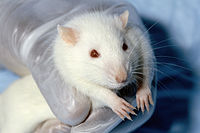
Photo from wikipedia
Background Cysticercosis and Neurocysticercosis (NCC) can be studied using several animal species in experimental models which contributes to the understanding of the human form of the disease. Experimental infections of… Click to show full abstract
Background Cysticercosis and Neurocysticercosis (NCC) can be studied using several animal species in experimental models which contributes to the understanding of the human form of the disease. Experimental infections of Taenia spp. are vital in explaining the modes of transmission of the parasite and helps the understanding of transmission of the parasite in humans and thus may be useful in designing therapeutic and immune-prophylactic studies to combat the disease. Thus, this systematic review aims to explore the existing experimental animal models to the understanding of cysticercosis in both humans and animals and elucidate the risk factors of cysticercosis and identify the Taenia spp. used in these models. Methodology We systematically identified all publications from the Web of Science, Google Scholar, and Pubmed regarding experimental animal models using Taenia spp. that cause cysticercosis in both humans and animals. 58 studies were identified for eligibility. Of these, only 48 studies met the inclusion criteria from which data extraction was done and presented descriptively. Results Pigs, cattle, gerbils, mice, rats, voles, monkeys, cats, dogs, and goats were used in which T. solium, T. saginata, T. saginata asiatica, T. crassiceps and T. asiatica were studied. The routes used to induce disease were; oral, intravenous, subcutaneous, intramuscular, intraperitoneal, intraarterial, intracranial, intraduodenal, and surgical routes using eggs, oncospheres, and proglottids. Besides, the establishment of infection using eggs and oncospheres was affected by the route used to induce infection in the experimental animals. The cysticerci recovery rate in all the experimental studies was low and the number of animals used in these experiments varied from 1 to 84. Although not analysed statistically, sex, age, and breed of animals influenced the cysticerci recovery rate. Additionally, the cysticerci recovery rate and antibody-antigen levels were shown to increase with an increase in the dose of oncospheres and eggs inoculated in the animals. Contrasting results were reported in which the cysticerci recovery rate decreased with an increase in the dose of eggs inoculated. Conclusion This review describes the various animal experiments using Taenia species that cause cysticercosis highlighting the animals used, age and their breed, the routes of infection used to induce disease and the sample size used, and the cysticerci recovery rate in these animal models.
Journal Title: PLoS ONE
Year Published: 2022
Link to full text (if available)
Share on Social Media: Sign Up to like & get
recommendations!